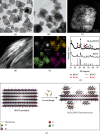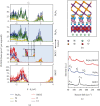Realization of Oriented and Nanoporous Bismuth Chalcogenide Layers via Topochemical Heteroepitaxy for Flexible Gas Sensors
- PMID: 35935140
- PMCID: PMC9275095
- DOI: 10.34133/2022/9767651
Realization of Oriented and Nanoporous Bismuth Chalcogenide Layers via Topochemical Heteroepitaxy for Flexible Gas Sensors
Abstract
Most van der Waals two-dimensional (2D) materials without surface dangling bonds show limited surface activities except for their edge sites. Ultrathin Bi2Se3, a topological insulator that behaves metal-like under ambient conditions, has been overlooked on its surface activities. Herein, through a topochemical conversion process, ultrathin nanoporous Bi2Se3 layers were epitaxially deposited on BiOCl nanosheets with strong electronic coupling, leading to hybrid electronic states with further bandgap narrowing. Such oriented nanoporous Bi2Se3 layers possessed largely exposed active edge sites, along with improved surface roughness and film forming ability even on inkjet-printed flexible electrodes. Superior room-temperature NO2 sensing performance was achieved compared to other 2D materials under bent conditions. Our work demonstrates that creating nanoscale features in 2D materials through topochemical heteroepitaxy is promising to achieve both favorable electronic properties and surface activity toward practical applications.
Copyright © 2022 Zhiwei Wang et al.
Conflict of interest statement
The authors declare no conflicts of interest.
Figures






Similar articles
-
2D Bi2Se3 van der Waals Epitaxy on Mica for Optoelectronics Applications.Nanomaterials (Basel). 2020 Aug 22;10(9):1653. doi: 10.3390/nano10091653. Nanomaterials (Basel). 2020. PMID: 32842700 Free PMC article.
-
van der Waals epitaxial growth of atomically thin Bi₂Se₃ and thickness-dependent topological phase transition.Nano Lett. 2015 Apr 8;15(4):2645-51. doi: 10.1021/acs.nanolett.5b00247. Epub 2015 Mar 30. Nano Lett. 2015. PMID: 25807151
-
Surface effects on electronic transport of 2D chalcogenide thin films and nanostructures.Nano Converg. 2014;1(1):18. doi: 10.1186/s40580-014-0018-2. Epub 2014 May 31. Nano Converg. 2014. PMID: 28191398 Free PMC article. Review.
-
2D Bi2Se3 materials for optoelectronics.iScience. 2021 Oct 14;24(11):103291. doi: 10.1016/j.isci.2021.103291. eCollection 2021 Nov 19. iScience. 2021. PMID: 34765917 Free PMC article. Review.
-
An ab initio investigation of Bi2Se3 topological insulator deposited on amorphous SiO2.J Phys Condens Matter. 2017 Feb 1;29(4):045302. doi: 10.1088/1361-648X/29/4/045302. Epub 2016 Nov 24. J Phys Condens Matter. 2017. PMID: 27882899
Cited by
-
Exploring chiral and achiral properties of novel multilayer 3D polymers: synthesis and characterization.RSC Adv. 2025 Jan 31;15(5):3227-3236. doi: 10.1039/d5ra00233h. eCollection 2025 Jan 29. RSC Adv. 2025. PMID: 39896428 Free PMC article.
References
LinkOut - more resources
Full Text Sources

